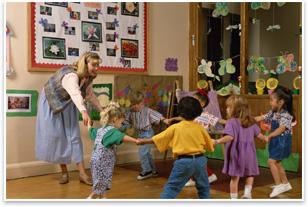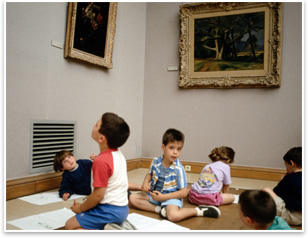The Architecture in the Schools Program Helps to Create the Ideal Client
by David R. Dibner, FAIA
Ed. note: In the spirit of volunteerism and community spirit with which it is written, we bring you this article, which was published originally on the AIA’s Architect’s Knowledge Resource Web site.
 Summary: The best architecture results from the interaction of a knowledgeable client and a creative architect. In the pursuit of our profession, too often we do not devote the necessary time to educate the public about the importance of architecture and the built environment so that they as clients can contribute their talents and understanding to creating better projects. However, there is a growing movement in which employees and owners of architecture firms invest a relatively small amount of time to helping future clients become more knowledgeable, and as a result our world becomes a better place. At the same time we learn quite a bit ourselves. Summary: The best architecture results from the interaction of a knowledgeable client and a creative architect. In the pursuit of our profession, too often we do not devote the necessary time to educate the public about the importance of architecture and the built environment so that they as clients can contribute their talents and understanding to creating better projects. However, there is a growing movement in which employees and owners of architecture firms invest a relatively small amount of time to helping future clients become more knowledgeable, and as a result our world becomes a better place. At the same time we learn quite a bit ourselves.
Do You Know the Architect’s Knowledge Resource?
The following AIA Best Practices on the Architect’s Knowledge Resource provide additional information related to this topic:
07.05.01 The Boyer Report: Building Community Through Education
07.05.03 Firms Benefit When They Charrette with Design Students
22.08.04 Kids in Architecture: A Grade 5 Curriculum.
Visit the Architect’s Knowledge Resource online.
 Dreams and Schemes: Stories of People and Architecture, by David R. Dibner, FAIA. Dreams and Schemes can be ordered from the AIA Bookstore by calling 800-242-3837 (option 4) or by sending an e-mail to bookstore@aia.org. Dreams and Schemes: Stories of People and Architecture, by David R. Dibner, FAIA. Dreams and Schemes can be ordered from the AIA Bookstore by calling 800-242-3837 (option 4) or by sending an e-mail to bookstore@aia.org.
Sowing the seeds
If you have been in practice for some time, you must have come to the realization that all “clients” are unique. They can range from individuals who may require small projects to corporations whose requirements and understanding of our profession are much more developed. But when you realize that the common denominator of all clients is that they are human beings like yourself, the equation becomes much simpler. All you have to do is to educate them about what you do, and what their part in the “doing” is, and you have a better chance of creating a more successful project.
Another way to look at it is to imagine that the world out there is like a garden and you and your fellow practitioners are the gardeners, raising the magnificent plants (the built environment) with the help of the plot owners (clients). If they truly understand how and why the built environment is created, your chances of ending up with a more productive, beautiful project is much greater—and you will likely be rewarded with greater spiritual and financial rewards.
It is important that more architects become sowers of the seeds of good architecture in the most fertile fields: students in elementary through high school when these future clients are in their most formative stages. They become the building users, owners, developers, and architects of the future. The potential benefits to the profession (and to humankind) of having more people aware of their physical environment and the important contribution that architects make to its betterment are enormous.
What training do you need?
If you are a person with an understanding of how architecture affects the built environment, are aware of how the environment affects people, enjoy working with youngsters in any aspect of the creative process, and have some free time (or can get your employer to allow you to you have some free time) to spend in a program, then you qualify to start teaching in an Architecture in the Schools program. What is needed is a motivated architect to connect with the children and describe what you and your fellow professionals do to improve their world.
You are not alone
Throughout the country there are many existing programs, some developed by AIA components, devoted to educating young people about architecture and the built environment. If you are interested in becoming part of this experience, first contact your local AIA component and ask what resources are available. Even if your local component does not have a standing program, materials are available that will help you to not only understand the process, but also provide specific teaching aids and curriculum guides.
Many architecture firms are involved in this valuable educational enterprise. They see it as a chance to contribute worthwhile services to their communities and as good public relations. Employers often allow employees to participate as individuals or as part of company teaching teams. The amount of “out of office” time is minimal (maybe 2 to 3 hours per week for 9 weeks). Volunteers’ compensation for this time varies with office policy. Some include it as overhead cost; others allow volunteers to make up the time separately. For intern architects, the time can count as community service credits for the Intern Development Program.
 Program description Program description
The main purpose of the program is for students to experience and understand their built environment, how it is created, and the contributions that architects and others make to its original design and later improvement. However, the specific requirements for each class will vary widely and must be flexible to meet many variables, including:
- Student grade level: K–12
- School location, which varies from inner city to rural, because the students’ surroundings are their “classrooms”
- Subject area: social studies, language arts, science, math, fine arts
- Students’ backgrounds—their own experiences form the background of the learning process
- Teachers’ priorities—emphasis should relate to their subject area; the teacher’s understanding of architecture is often just as basic as their students
- Volunteers’ experience—it is best when volunteers are able to talk from personal experience and knowledge.
Some teaching techniques
The approach to conveying knowledge about the built environment is as varied as the subject itself and may include:
- Examining or drawing a map of the neighborhood and discussing street patterns, parks, pedestrian circulation, zoning, and other restrictions
- Learning about materials, measurements, scale, and shapes
- Taking field trips to learn about utilities, infrastructure, street furniture, etc.
- Learning the vocabulary of building elements
- Learning basic structural principles and engineering systems
- Understanding plan, elevation, and section views
- Learning some architectural history and how building forms have evolved
- Understanding the concepts of environmental preservation and green building
- Learning how architecture is the responsive art by discussing with parents and siblings a functional program for designing their new house
- Working together to design and build an architectural model
- Visits to your office, construction sites, etc.
- And much more, limited only by your imagination.
 Getting started Getting started
The AIA component will contact a local school and ask whether they would like to participate in the program. The school should submit information about the classroom teacher as to what he or she would like to see accomplished during the course. The component then requests volunteers from its membership for each specific school program. A short orientation meeting should be held to make sure that the teachers and volunteers are in tune with each other as to their goals.
A class syllabus showing the objectives of each of the class sessions is developed through discussions by the volunteer and the teacher. The classes are held usually once a week for nine weeks. The course ends with a final project, usually a model, which is then displayed in the school and/or other public place.
Your rewards
Volunteers have described many different rewards they have gained from their teaching experience, including:
- The pride of accomplishment on the students’ faces as they demonstrate their projects at the end of the course
- The pride and joy when a student is able to resolve open-ended problems on their own using the “design tools” that were discussed in class
- Watching young children see the built environment from a different perspective
- Showing off just how much fun it is to be an architect … and seeing the students starting to consider architecture as their future profession
- Learning how architecture is contagious as they watch the students tell their families and friends about the built environment
… And knowing that this process will contribute to a more beautiful, functional, and healthy world.
The Back Story
Articles such as this one from the Architect’s Knowledge Resource help the AIA and its members achieve the Institute’s strategic goal to:
“Be the Authoritative Source—be the recognized leader for knowledge about the practice and profession of architecture, specifically:
Deliver knowledge to members and the industry: Be the conduit of knowledge that advances the profession and is accessible through virtual and physical experiences, including continuing education, knowledge communities, resource centers, the AIA convention, state and local components, an integrated Web presence, and research.”
Learn more about the Architect’s Knowledge Resource and how you can share information. |


 Summary:
Summary: Dreams and Schemes: Stories of People and Architecture, by David R. Dibner, FAIA. Dreams and Schemes can be ordered from the AIA Bookstore by calling 800-242-3837 (option 4) or by sending an e-mail to
Dreams and Schemes: Stories of People and Architecture, by David R. Dibner, FAIA. Dreams and Schemes can be ordered from the AIA Bookstore by calling 800-242-3837 (option 4) or by sending an e-mail to  Program description
Program description Getting started
Getting started